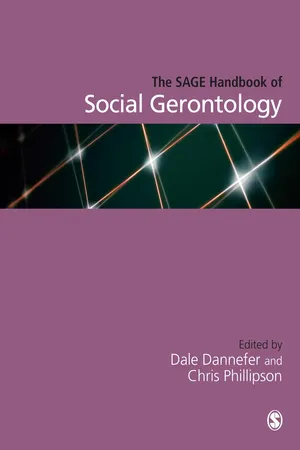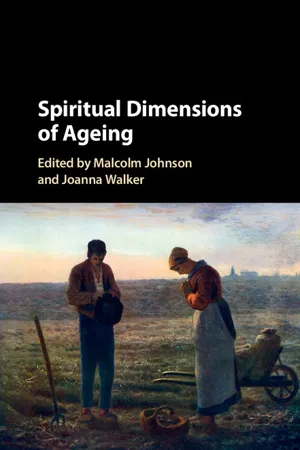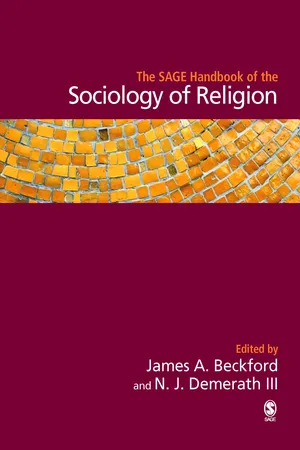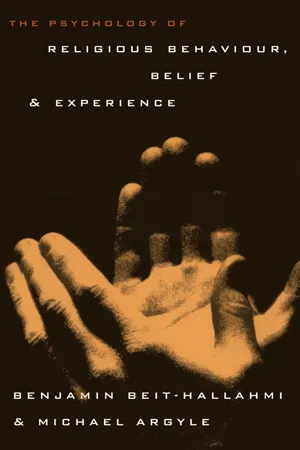Social Sciences
Age and Religion
Age and religion refer to the relationship between an individual's age and their religious beliefs and practices. Studies in this area explore how age influences religious participation, beliefs, and attitudes. Research often examines how religious affiliation and commitment change across different stages of life, and how generational differences impact religious identity and behavior.
Written by Perlego with AI-assistance
Related key terms
1 of 5
4 Key excerpts on "Age and Religion"
- eBook - PDF
- Dale Dannefer, Chris Phillipson, Dale Dannefer, Chris Phillipson, Author(Authors)
- 2010(Publication Date)
- SAGE Publications Ltd(Publisher)
Religion and Age P e t e r G . C o l e m a n 12 INTRODUCTION Religion has played a relatively small part in social gerontological studies, a fact which itself requires explanation in the light of the strong associations between religious involvement and age observed in many cultures. For a large part of the 20th century, religion was viewed with disdain as an uninteresting phenomenon with limited implications for furthering study of the individual and society. In fact, research on religion was considered dam-aging for career prospects in the social sciences (Levin, 1994). As Baumeister (2002) has noted, academics, and social scientists in particular, tend to be less religious than the general population. As a consequence, many feel inexpert and ill at ease studying religion. Concerns have recently been raised at this deficiency as Western societies face increasing threat from religious-based terrorism. However, the last 10–20 years have seen a marked growth of interest in the social scientific study of religion and the related concept of spiritu-ality. This is not only because of the greater role of religion in politics and society but also because of the increased recognition of the role religious and spiritual beliefs can play in maintaining personal well-being and even physical and mental health. The latter focus has been particularly evident in gerontological research. However, one consequence of this has been an imbalanced view of religion, focusing on extrinsic benefits rather than on the central functions of religion in later life. The defini-tion of what counts as religion is itself not a straightforward matter (Hill and Pargament, 2003), but in this chapter will be taken to refer to a shared system of beliefs and associated practices based on a transcendent view of life, arising usually as the result of revelation from a perceived sacred source. - eBook - PDF
- Malcolm Johnson, Joanna Walker(Authors)
- 2016(Publication Date)
- Cambridge University Press(Publisher)
A set of messages that have yet to penetrate the thinking of older believers. As this brief review suggests, assessing whether individuals become more religious as they move through the life course and into in their later years is complex. It requires that we take into account not only individual development or biographical ageing, but also the often unique effects associated with cohort membership: being born and growing up within a particular historical interval. Moreover, there are historical contexts and cultural changes that can affect all age groups, but not always to the same degree. There are many examples of all-age cultural/religious shifts throughout history. Across medieval and post – Reformation Europe, monarchs, Christian, Jewish and Muslim leaders have moved the bound- aries of accepted beliefs. McDonnell and Lang (2001) in their comprehen- sive history of heaven and ideas about it, provide a template of the manner in which wider populations of the powerless faithful have seen central religious ideas reformulated. In turn, these pieces of ecclesiastical revision- ism cause uncertainty and sometimes anguish, particularly in the old. Research Findings from a 35-Year Longitudinal Study Do people get more religious as they age, with the approach of the end of life? To what extent are there cohort differences in this? And what about historical or period effects, reflecting that broad cultural trends such as increased secularization may influence age changes and age differences in 90 Vern Bengtson and Malcolm Johnson religion? These issues have been examined empirically (Bengtson, Sil- verstein, Putney, and Harris, 2015) using a set of unique data from the 35-year Longitudinal Study of Generations. This analysis used growth curve estimations across eight waves of data collection, from 1970 to 2005, to trace age and period changes in dimensions of religiosity among family members representing four generations. - James A Beckford, Jay Demerath, James A Beckford, Jay Demerath(Authors)
- 2007(Publication Date)
- SAGE Publications Ltd(Publisher)
These developments invari-ably prove important given the fact that the various stages of life were once commonly associated with fairly distinct and non-divergent religious values and beliefs. Today it is ever more arduous to forge generalizations regarding age categories and broad religious orientations. This is not to suggest they are entirely obsolete since empirical studies continue to establish a link between religiosity and age, and such a relationship forms much of the discussion below. Nonetheless, it is the larger picture which must be appraised, one where religious socialization is of decreasing importance and where a culture of choice has become recognized as a cultural development which cuts across generational boundaries. Certain developments identified with the onset of modernity had previously eaten away at one essential dimension of religiosity: the significance of rites of passage. This is evident in Bryan Wilson’s elucidation of the theme of secularization which contended that religion would invariably decline with an underpinning rational-orientation of social life on the one hand, and a reduction in common values and the breakdown of collectivities that upheld shared religious conviction on the other (Wilson 1976). This decline of community in modern industrial society resulted from high levels of social and geographical mobility and consequent changes in the nature of social control. It followed that the authoritative moral and religious foundation of well-integrated communities could no longer be upheld and was evident in the demise of the rites of passage. Hence, the decline of rituals related to the essen-tial ‘turning points’ of life, alongside church attendance and other forms of religious obser-vance, provided the evidence of ongoing and relentless secularization. Paradoxically, then, the same modernity which increased the number of ‘stages’ of life, also stripped them of rites of pas-sage.- Benjamin Beit-Hallahmi, Michael Argyle(Authors)
- 2014(Publication Date)
- Routledge(Publisher)
Chapter 7 ) and polarization, some moving towards religion, some moving away.Identity formation goes through several stages, in the areas of occupational choice, sexual orientation, politics, and religion. McAdams et al. (1981) studied the religious identity of 56 students in depth, and distinguished between those at different levels of identity achievement. Those who were at the higher levels of identity in the religious sphere were also at higher levels on measures of complexity of ego-development, and had higher scores on measures of formation of a coherent identity. They also had higher scores on intimacy motivation, seeing God as an intimate companion, and appreciating communal rituals.Adults: 23–60In some of the earlier literature (Argyle and Beit-Hallahmi, 1975) the evidence seemed clear – there was an apparent decline in religious belief and activity between ages 18–30 followed by a rise to old age. There was always some doubt that what looked like effects of age might be partly or wholly due to historical, cohort effects, such as secularization or revival. Various attempts have now been made to separate the effects of age and history. Stark (1973) examined the results of a US survey, and found no increase with age for religious belief and behaviour; there was, however, a break between those who grew up before and after the Second World War – those from the earlier period being more devout. On two measures there was still an increase with age – belief in an after-life and private prayer (see below). Ploch and Hastings (1994) used data from successive US surveys carried out between 1972 and 1991. Some of their findings are shown in Figure 8.2
Index pages curate the most relevant extracts from our library of academic textbooks. They’ve been created using an in-house natural language model (NLM), each adding context and meaning to key research topics.



